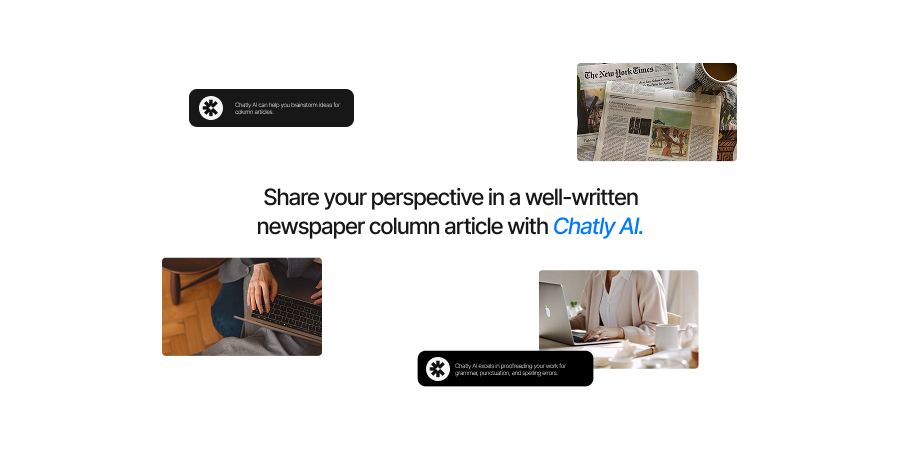
How to Write a Newspaper Column Article in 2025 (Tips, Techniques, and Examples)
The goal is not just to inform but also engage readers by offering different perspectives on different ideas. Understanding how to write a newspaper article that is clear, compelling, and informative is essential for any writer looking to step into the world of journalism.
In this article, we'll cover the basic structure of a news article, the role of journalistic writing, and how to effectively write a column for a newspaper.
Understanding the Structure of a Newspaper Article
It doesn’t take much to attract an avid newspaper reader to your column. But if you want to win the attention of an occasional reader, you need to be clear about what to write and how to present it. You can do it by writing your story in an easy-to-follow news article format.
- Headline: The headline is the first impression a reader gets of your article. It should be engaging, clear, and encapsulate the essence of the story.
- Byline: This is where you identify the writer of the article. It may also include the publication date.
- Lead (Lede): The lead is the opening paragraph, summarizing the most critical information of the article. It should answer the who, what, when, where, why, and how.
- Body: The body of the article contains the main details, facts, and supporting information, arranged in descending order of importance.
- Conclusion: This section wraps up the article. In some cases, it may leave the reader with a thought-provoking question or final statement.
Here is a simple new paper article example to give you an idea of what your column piece should look like:
-
Headline: "New Tax Reform Bill Passes in Congress"
-
Byline: By John Doe, Published on October 15, 2025
-
Lead: The U.S. Congress passed a new tax reform bill this morning aimed at reducing corporate taxes and providing tax relief for middle-income families.
-
Body: The bill, which was passed with a 220-200 vote, is expected to have significant implications for both small businesses and the wealthiest Americans. The legislation introduces several new tax brackets and includes provisions for...
-
Conclusion: Proponents of the bill argue that it will stimulate economic growth, but critics say it disproportionately benefits the wealthiest citizens.
The Role of Journalistic Writing in Newspaper Columns
Having simple writing skills is not enough for a successful newspaper column article. You also need to be proficient in journalistic writing. Follow the same instincts you follow while writing a journalistic article while ensuring complicity with news writing essentials.
One thing to notice is that news writing typically focuses on presenting factual information without the writer’s opinions or emotions. In contrast, column writing allows for more creativity and opinion, but it still requires a commitment to truth and fairness. But regardless of what you are doing, journalistic writing ensures that your work is credible and impactful.
How to Write a Newspaper Article
Writing a compelling newspaper article requires careful research, organization, and skill. Here’s how to approach the process:
Research and Gathering Information
Before you start writing, it's important to gather as much relevant information as possible. Reliable sources such as interviews, reports, and official statements will provide you with the facts necessary to build a strong story. Assisting your research with AI Search ensures that your article is well-informed and fact-checked, which is vital in news writing.
Choosing the Right Topic
Your topic should be timely, relevant, and interesting to your audience. So it becomes important to be up-to-date on current affairs and be active on social media to find new stories. Whether you're writing about a local event or a global issue, make sure that the subject matter is engaging and important to your readers.
Writing the Lead
Writing a journalism lead is one of the most important elements of a newspaper column article. It should capture the essence of the story and hook the reader immediately. People want hard-hitting facts and they want them quick. So, a strong lead will give readers a reason to continue reading.
Supporting Details and Quotes
After writing the lead, the body of the article should provide additional details that support the information in the lead. This includes facts, statistics, and expert opinions. Including direct quotes from people involved in the story adds authenticity and authority to your article.
Crafting a Strong Conclusion
A good newspaper article always ends with a strong conclusion. It should summarize the key points, reiterate the importance of the story, and leave the reader with something to think about.
Different Types of Column Articles for Newspapers
Newspaper column articles can take many forms. Each type has specific rules, norms, and formats that suit its purpose. Understanding these variations is crucial when deciding how to write a newspaper article for a specific type of column.
1. Opinion Columns
Opinion columns express the personal views of the writer on a particular topic. They are subjective and can be persuasive, aiming to influence the reader’s perspective on an issue.
-
Norms: Opinion columns are more personal and subjective than news articles. They allow the writer to voice their views, supported by evidence.
-
Format: Typically includes an engaging introduction, followed by detailed arguments and a persuasive conclusion.
2. Editorial Columns
Editorial columns are written by the editorial board or senior staff of the newspaper. They reflect the publication’s official stance on an issue, such as politics, social matters, or global events.
-
Norms: The tone is formal and authoritative, and the piece is impersonal, focusing on the publication's viewpoint rather than individual opinions.
-
Format: An editorial typically opens with the issue, followed by an analysis, and ends with a call to action or a statement of the publication’s position.
3. Feature Columns
-
Norms: These columns use engaging storytelling, often involving interviews, anecdotes, or personal experiences.
-
Format: A feature column usually starts with a compelling hook, followed by a narrative or exploration of the topic, and ends with a reflective or uplifting conclusion.
4. Advice Columns
Advice columns are aimed at helping readers with personal issues, ranging from relationships to career advice. These columns respond to reader-submitted questions or dilemmas.
-
Norms: The tone is supportive, friendly, and empathetic. Advice columns are often personal and provide tailored solutions.
-
Format: The writer introduces the reader's issue, offers advice, and provides a conclusion that reinforces the guidance.
5. Political Columns
Political columns focus on political analysis and commentary. These columns examine government policies, political events, and current issues from a political perspective.
-
Norms: Writers need to back up their arguments with data, expert opinions, and facts. The tone can vary from critical to supportive.
-
Format: Political columns usually start by explaining the political issue, followed by analysis, and conclude with a summary of the writer’s view on the subject.
6. Humor Columns
Humor columns use wit and satire to entertain readers. They often comment on current events or societal trends in a funny or exaggerated way.
-
Norms: The tone is light-hearted and humorous, often involving sarcasm, irony, or satire.
-
Format: Humor columns typically begin with a funny observation or anecdote, expand on it with humor, and end with a punchline or witty conclusion.
7. Sports Columns
Sports columns provide commentary and analysis on sports events, athletes, and teams. They often include performance evaluations and predictions.
-
Norms: These columns require in-depth knowledge of the sport being discussed. The tone can be passionate, analytical, or celebratory.
-
Format: Sports columns typically begin with a recap of the game or event, followed by analysis, and conclude with commentary on the performance or future implications.
How Chatly AI Can Help
1. Generating Article Ideas
Chatly AI can help you brainstorm ideas for column articles. By providing relevant keywords or topics, Chatly can generate a list of article ideas based on current trends, historical context, or popular discussions, making it easier for journalists to find fresh and relevant topics to cover. You can then use AI chat to further refine the ideas so you can start the writing process.
2. Enhancing Writing Style and Clarity
One of the challenges of newspaper column writing is maintaining a clear, concise, and engaging style. Chatly AI can analyze your writing for clarity, readability, and tone. By offering suggestions for sentence structure, vocabulary improvements, and adjusting the tone to match the audience, Chatly ensures that your article stays aligned with journalistic standards while still being engaging.
3. Proofreading and Editing Assistance
Chatly AI excels in proofreading your work for grammar, punctuation, and spelling errors. It can also spot awkward phrasing or repetitive wording that might hinder the flow of your article. By using Chatly for editing, writers can improve the overall quality of their newspaper column articles, ensuring they meet editorial standards.
4. Research Support
Chatly can assist with research by providing summaries of key information, relevant articles, or historical references. This saves time and ensures your article is well-informed, reducing the risk of inaccuracies. With its access to a broad range of knowledge, Chatly helps writers include relevant facts and supporting details, making their articles more authoritative.
5. Generating Headlines and Subheadings
Creating attention-grabbing headlines is crucial for any newspaper column article. Chatly AI can assist by suggesting multiple headline options that are catchy, SEO-friendly, and aligned with the article’s content. This ensures that your column draws in readers right from the start.
6. Content Optimization
Whether you’re writing an opinion piece or a feature column, Chatly can help optimize your article’s content for clarity and engagement. It can suggest edits to make your writing more concise, impactful, and reader-friendly, without compromising on the message.
Common Pitfalls to Avoid in Newspaper Writing
Even experienced writers can fall into common traps when writing newspaper columns. Here are a few pitfalls to watch out for:
- Bias: Always ensure your writing is objective, especially in news articles. Opinion columns can express personal views, but they must be backed by solid evidence.
- Overloading Information: Avoid overwhelming the reader with too many facts or complex data points. Keep it concise and focused on the core message.
- Jargon: Keep the language accessible to a wide audience. Avoid using technical jargon unless it’s appropriate for the target readers.
Final Steps and Editing Process
Once your article is written, it's time to refine it. Here’s how you can perfect your work:
- Reviewing for clarity, grammar, and structure: Ensure that your article is easy to understand and free from errors.
- Proofreading: Always double-check your work for spelling, punctuation, and factual accuracy.
- Feedback: Ask peers or editors for feedback before submitting the article.
Conclusion
Writing a newspaper column article requires understanding its structure, purpose, and audience. Whether you are writing an opinion column, a feature, or a political analysis, following the right format and adhering to journalistic principles will help you produce high-quality, engaging work. Master the art of newspaper article writing by practicing these techniques and refining your skills over time.
Frequently Asked Question
Here are the solutions to some other people's problems.
More topics you may like

10 Different Ways You Can Use Chatly AI Chat and Search Every Day

Faisal Saeed

24/7 Customer Support with AI Chat: Benefits, Examples and More

Muhammad Bin Habib

28 Best AI Tools for Students in 2025 – The Complete AI-Powered Academic Success Guide

Muhammad Bin Habib

11 Best ChatGPT Alternatives (Free & Paid) to Try in 2025 – Compare Top AI Chat Tools

Muhammad Bin Habib

How to Decline an Internship Offer Professionally and Politely

Muhammad Bin Habib
